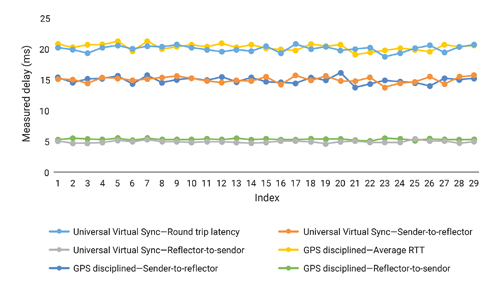Resolving Latency Issues That Affect Carrier Networks and Quality of Experience
EXFO is leading the development of this technology, which it terms “Universal Virtual Sync.” According to Diallo, the technology leverages EXFO’s existing Active Verifier physical or virtual network probe devices. “It has the ability to learn about the endpoint, and about the responder on the far end,” which means the software can locally provide a correction factor (a clock offset) that provides a very accurate view of one-way latency.
Using this technology, the responder has a hardware-based timing system that leverages the RFC-5357 TWAMP (Two-Way Active Measurement Protocol) or Y.1731 SOAM-PM standards found in most switches, routers, cell-site routers, and other similar devices.

Fig. 1 – GPS vs. One-way Latency Testing
(Click Image to Expand)
“We’ve set up a mechanism that allows for the very accurate measurement of one-way delay to any standards-based responder,” he explained. “You can leverage the same monitoring used to assure your backhaul or Layer 2/3 circuits.” Based on that data, network managers can still calculate two-way traffic metrics when needed, but have the one-way traffic data required for spotting problems and remediating issues.
EXFO’s new approach has the potential to reduce CAPEX by reducing the need for GPS-based time synchronization devices, which can be expensive to install and maintain. It also has the potential to reduce OPEX by helping to identify problems more accurately and to reduce troubleshooting time. And of course, there are bottomline benefits of more accurately measuring and maintaining a positive QoE to improve customers' loyalty and reduce churn.
Evolving From Round-Trip Metrics To Bidirectional Latency Measurement
Cisco’s Visual Networking Index predicts IP-video traffic to be 82 percent of all consumer traffic by 2021. That means more than 80 percent of network traffic can be significantly affected by latency, and if the delays raise the potential to affect QoE, traffic engineering or other steps can be taken to address the underlying problems and reduce that latency. While the latency caused by transport distances generally cannot be resolved, other causes of latency can be, but only if latency metrics are based on accurate unidirectional metrics that not only show the proper upstream or downstream delay, but also their origin.
For those still measuring network latency by dividing in half round-trip packet time, the time has come to abandon that approach. It has become too expensive and inaccurate for today’s digital service providers. The better path is to embrace more accurate bidirectional latency measurement, which can not only improve customer satisfaction, but also potentially reduce both OPEX and CAPEX.



















